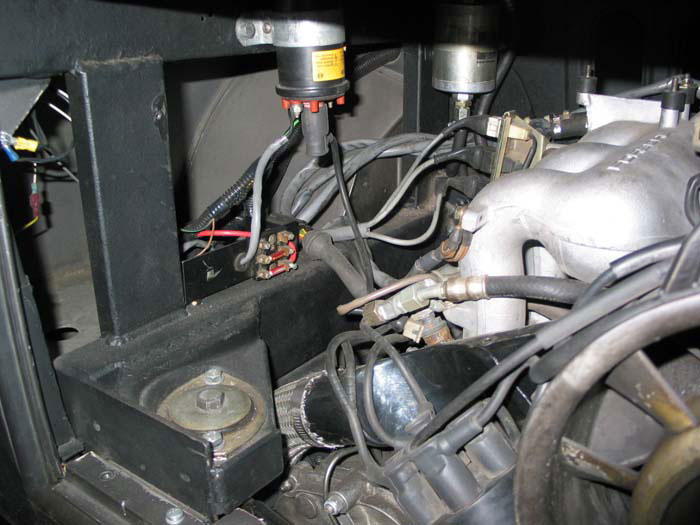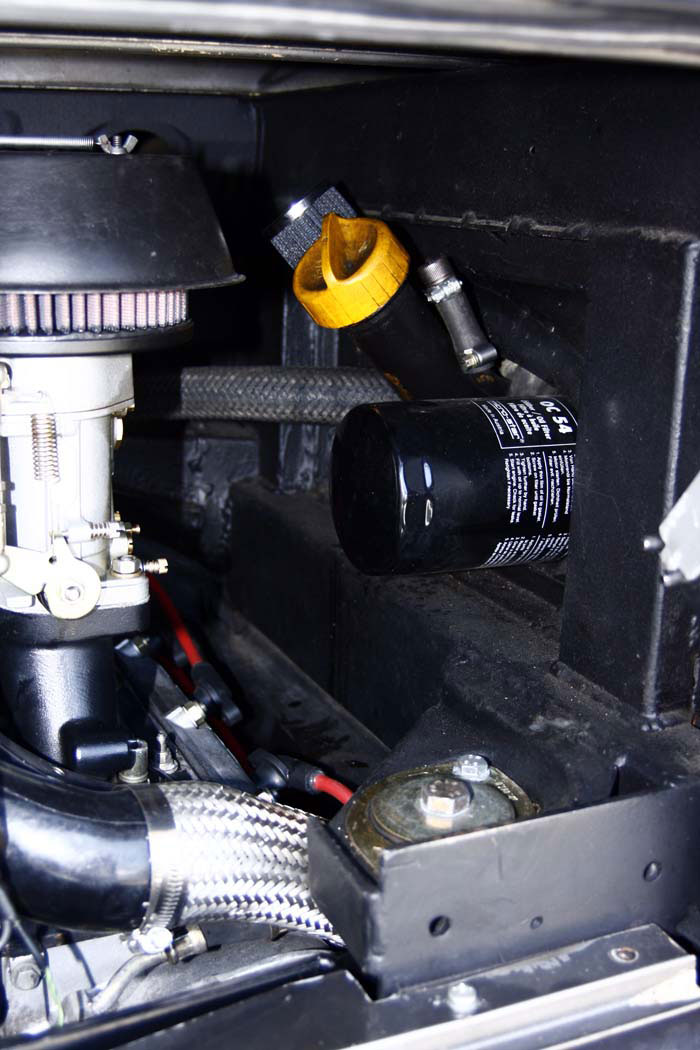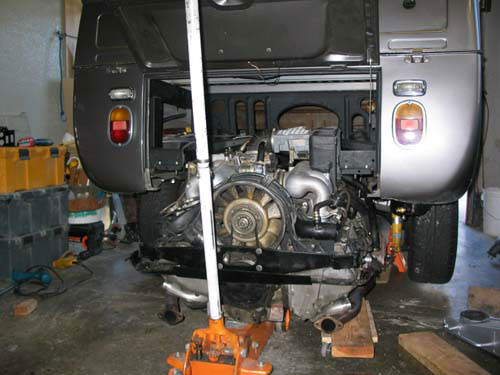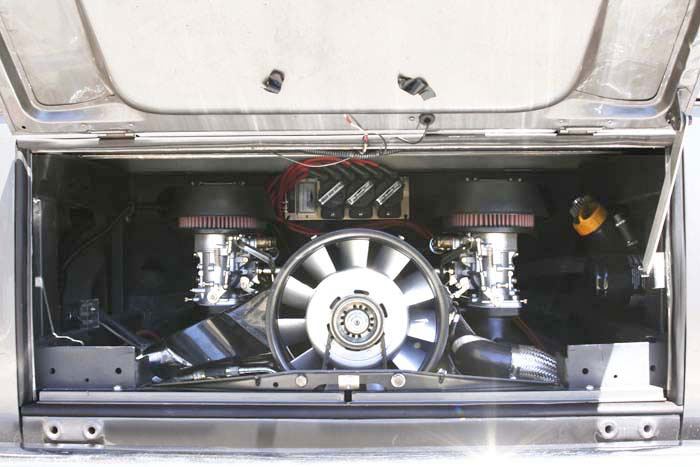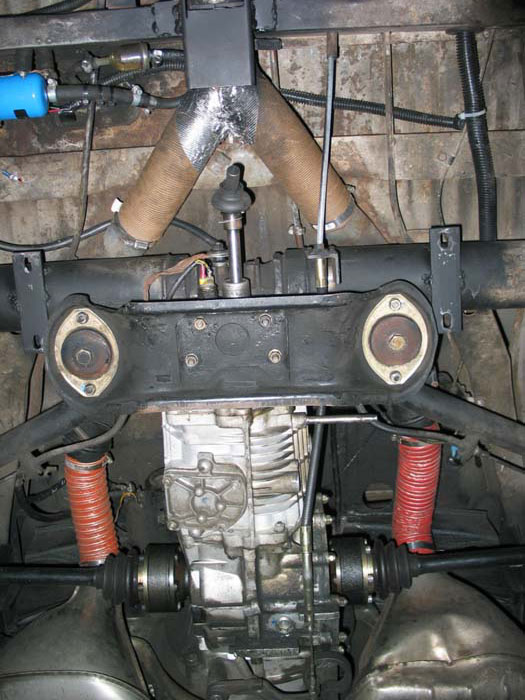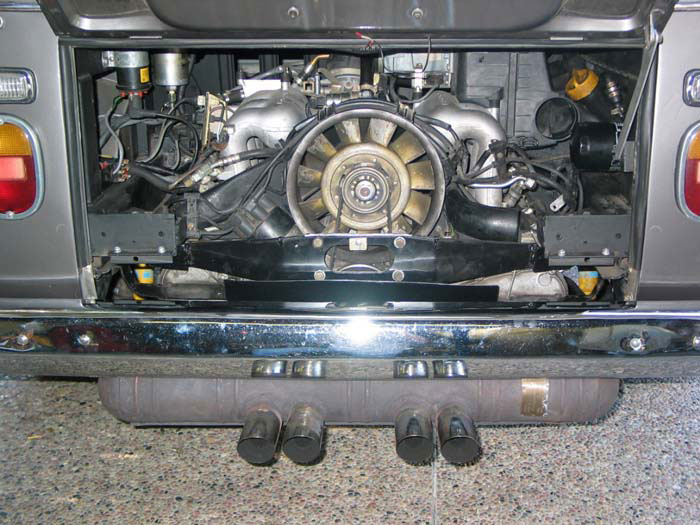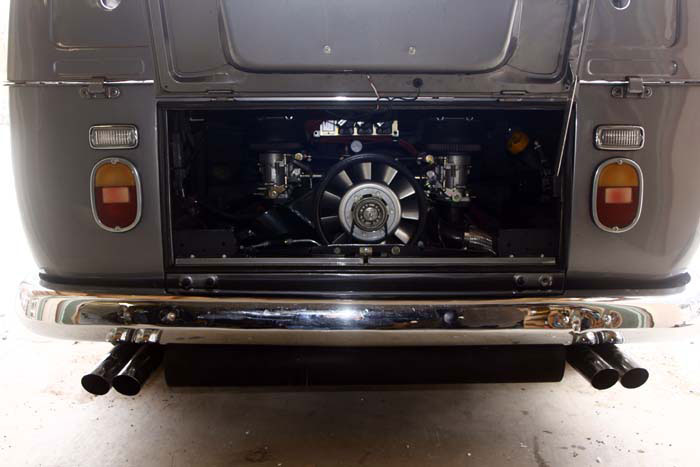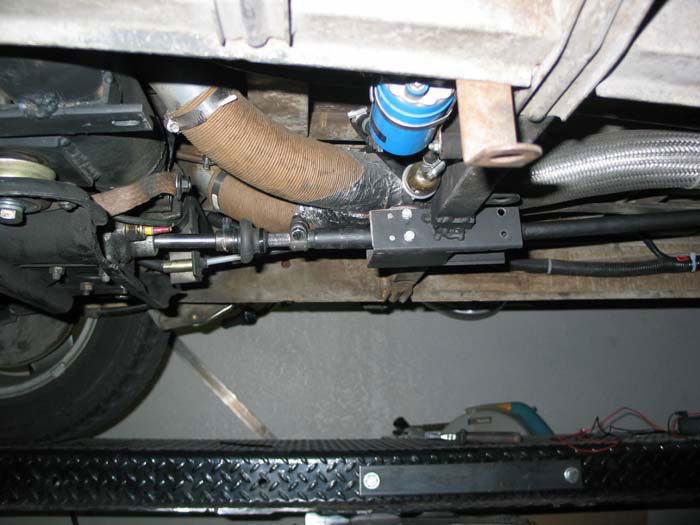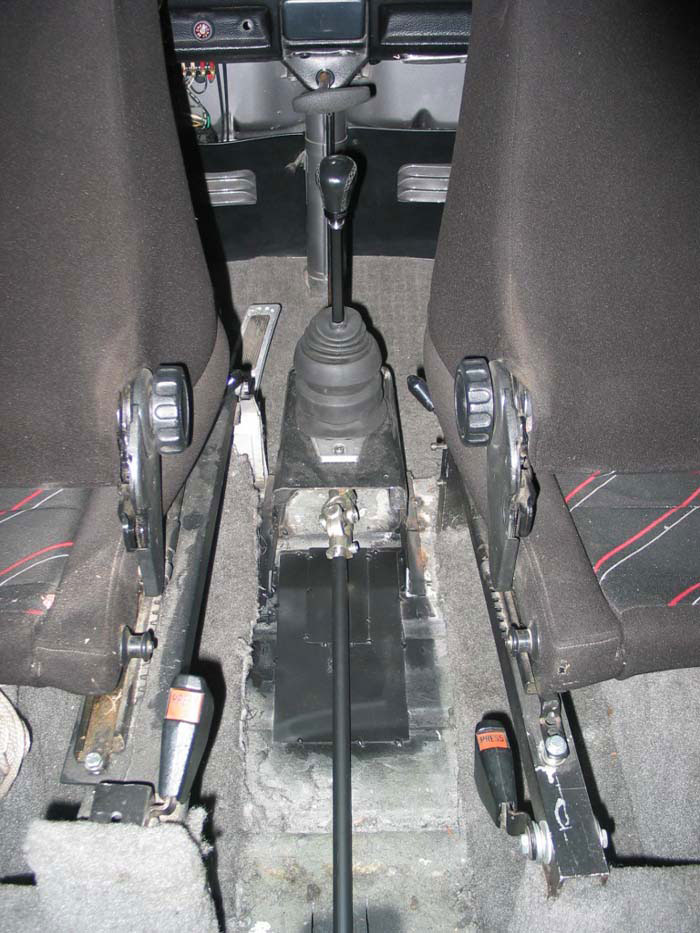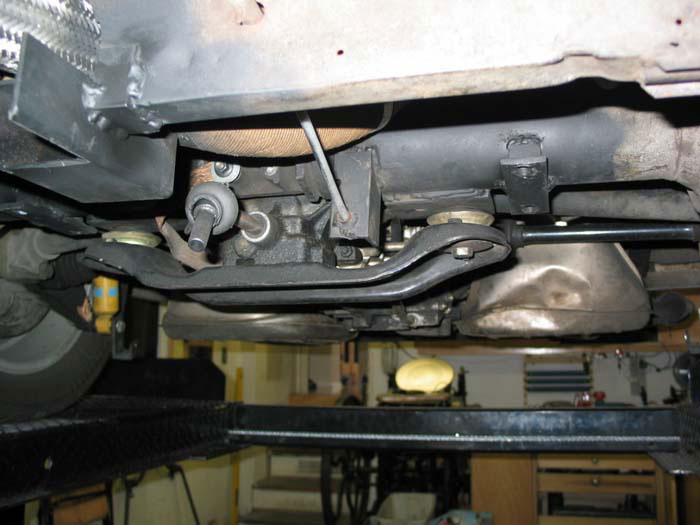1985-1993
2000
2003-2006
2008-2009
2015-2020
My 1968 VW Type 2 Bus Conversion

From 57 h.p. 1600cc Type 1 to 245 h.p. 3200cc 911.
Porsche Engine Conversion
by Harold Williams
December 2011
A Brief History
My long quest for Porsche power started when I read an article about Porsche installing a Porsche drive-train in the VW Vanagons that were used as support vehicles for the Dakar rally.
In 2000 we bought a totaled 1986 911 with the plan of installing the 3.2 engine and transmission into our '73 911E Targa. This left the stock 2.4E and transmission sitting there. I persuaded my Porsche mechanic to install the 2.4 motor and transmission into the Crewcab. The motor was freshened and converted to 40mm Weber carbs prior to installation. My mechanic agreed to hang the motor & transmission and get it running, then I would take the project over.
In 2003, we decided to sell the Targa with the original motor, so I swapped the 2.4E motor out of the Crewcab and replaced it with the 3.2 motor and transmission.
Here is a overview to give you an idea of what's involved although there are multiple approaches one could take in converting to a Porsche motor. (Click on the pictures to enlarge.)
Engine Bay Prep
The horizontal frame rails were cut out from the firewall to the rear apron. The motor & transmission were set in place to locate the engine and transmission mounts. 2 x 4 x 1/4" rectangular steel was welded in to replace the frame rails. 1" x 3" steel uprights tied the new frame rails into the horizontal rails that support the bed. Stock 911 motor mounts were welded to the new frame. Stock transmission mounts were welded to the bottom of the torsion tube as well as a clutch cable bracket, and sway bar brackets. No modifications to the torsion tube were necessary. The engine hanger was notched and angled forward to line up with the motor mounts. To simplify mounting the oil tank, a 911 inner fender which housed the oil tank was welded in, and the oil tank was installed. The engine and transmission were installed. Axles from a '77 911 turned out to be the right length and were a direct bolt on. I tried running the throttle cable a few different ways, including the stock 911 set up. I ended up installing the throttle cable tube back in its stock VW location.
Initially we retained the stock VW shifter, and made a make-shift gas and clutch cables, and shift linkage. A stock 911 muffler was used. I made a dash out of walnut and installed the 911 tach, oil temperature/pressure gauge, and the speedometer. I used the stock bus speedometer cable that drives off the left front wheel.
At this point, the Crewcab was running and the mechanic's job done. It was my turn to take over the project. While it drove okay, there were a few issues. Most pressing were that the shifting was vague and hard, I was only getting partial throttle, and the engine seals were missing. To install the seals, the motor came back out.
I bought the rear cross brace that incorporates the shock towers and the shift tunnel out of a 911 from a Porsche recycler. Since I wanted to use the factory engine seals it was easier to use a factory cross brace. I also added 1"x2"x1/4" rectangular steel to the bottom of the 2"x4" frame rails. This gave me a place to mount the factory engine seal channels that hold the side rubber engine seals as well as the bumper. The VW rear apron was trimmed to fit around the engine hanger.
The stock muffler was no longer going to work with the rear apron and bumper, so it was temporarily replaced with Supertrapp mufflers. I went on to try a few custom muffler set ups, and settled on a Abarth 4 tip muffler designed for the 2.2 motors. It cleared the apron and a notch was cut into the bottom of the bumper.
Installing the 3.2
In 2003 we decided to sell the '73 Targa. The 3.2 motor and transmission were swapped out of the Targa for the original motor and trans, now in the Crewcab. During the 3.2 motor's life in the Targa, I installed a custom chip, SSI heat exchangers and a sport muffler. This bumped the power up to 230 h.p. range. The '84 transmission was rebuilt swapping out the stock 8:31 r&p for a 7:31 and early 5th gear. This gave a much better bottom end while sacrificing some top speed. Installing the 3.2 involved a little more work since it retained the stock intake, which required using the ecu (mounted under the rear seat), wiring harness, matching tach and electronic speedometer. A stock high pressure fuel pump was used, and a fuel return line was added to the top of the gas tank. The motor ran great for awhile. Then I started having intermittent engine cut out. I thought it was a problem with the ecu but later discovered it was a faulty fuel pump. Anyway, this was the excuse I needed to convert the motor to 46mm PMO carbs and Electromotive crank fire ignition for the old school look. Gas milage did suffer. I went from 18 m.p.g. with the stock intake to 12-14 m.p.g. with the carbs. I also added a after market 911 oil cooler kit from BAT. This consists of the cooler, thermostat, and fan. The cooler is mounted underneath
the Crewcab. The fan is controlled by a switch on the dash.
I used the stock 911 fuel pump with the stock 3.2. and switched to a Mallory Competition 4070 fuel pump when I converted to carbs. The PMO fuel pressure regulator with gauge was used to set the 3.5 psi for the carbs.
On the 2.4, I fit an Abarth 4-tip exhaust (designed for a 2.2 911). No modifications were needed to the apron, but I did cut a section out of the bottom of the bumper to clear the muffler. On the 3.2, the Abarth muffler no longer worked as it was too restrictive. I made a few exhaust systems from scratch, and finally came up with one that was pretty well hidden, has a nice sound and flows well. The dual tips are made by Monza and can be swapped out.
Heat
The 911 heat exchangers give off more than enough heat to warm up the interior. I mounted a pair of 911 heater flapper boxes to be able to use the stock bus heater lines. I made a Y fitting to tie into the stock VW heater tube. The problem was it sounded like there was a microphone in the engine compartment and the heater vents inside the cab where the speakers. I cut a section ot the stock heater tube out and replaced it with a "cherry bomb muffler". This took care of most, if not all the noise.
Transmission
I originally used a stock '73 transmission with the 2.4E motor. This has the 7:31 ring & pinion. When I switched to the 3.2 the matching transmission was used. This was done because of the sensors needed for the stock intake. As I mentioned above, the transmission had been modified, swapping out the 8:31 r&p for the 7:31 r&p. The newer transmissions are stronger than the earlier ones, and can handle more power. I think the drive flanges had to be changed out to mate up to the '77 911 cv joints. I also used a Sachs sport clutch and pressure
plate.
Shifter & Shift Linkage
I tried a number of linkage configurations with the stock VW shifter,
but none of them worked very well. I decided to install a Porsche
shifter and figured the easiest way was to weld in a section of a 911
tunnel that housed the shifter. After trying a few shift rod
configurations, I made a 2 pc. shift rod and angled it to come out
just ahead of the transmission shift rod. The frame rail was notched
and a rectangular piece of steel was welded in to house a stock shift
rod bushing. An after market shift rod coupler was used.
I wanted to use a specific aftermarket shifter for my installation which required using the stock shift housing. I had to make quite a few modifications to the shift housing to get everything to work. Since that time a company called Hargett (no affiliation) has come out with a shifter and housing for a 911 that would be much easier to install in the Crewcab.
Suspension
The front suspension consists of an Albatross front adjustable beam. After trying a number of shock absorbers I had Koni make a custom set of aluminum bodied double adjustable shocks. The shocks also have provisions for coil over springs. They were originally speced out to their "B2" settings, which is their second softest setting. I had them re valved to the their "B1" setting, which is the softest. The compression & rebound is set up 2 clicks from the softest setting. A sway-a-way 22 mm sway bar is used.
The rear suspension has 27 mm torsion bars and heavy duty spring plates. The rear shocks are a custom spec (by Wevo) single adjustable Ohlins shock. This was a direct bolt on. These are the same shocks we use on our '75 Carrera race car, and are also used on modified street 911's. I made up some brackets and mounted a pair of re-valved (R10 Smart Racing) Porsche RSR coil over rear shocks for comparison. Both shocks can be used with or without coil over springs. The Sway-a-way rear sway bar was also modified. With one side of the bar bolted to the bottom shock bolt I could pull the other bar down 4-5 inches with little resistance. This means the Crewcab would need to lean more than 4-5 inches before the bar did anything. I cut approximately half the length off, made new ends and mounted it to the trailing arm bottom bolts. This resulted in the front end tucking better going into corners.
Brakes
You can read about my front & rear disc brake conversion by clicking here.
My goal in that conversion was to try and keep it affordable by retaining the stock 15" wheels and using off-the-shelf parts.
Miscellaneous Porsche parts used
- Right side inner fender w/oil console, oil tank, and oil lines.
- Rear cross brace with the shock towers.
- "C" channel for the engine seals, as well as the front,side & back engine seals.
- 1977 911 axle assemblies.
- Heater flapper boxes.
- Gauges w/matching oil temp & pressure sensors
- 911 shifter housing & coupler
- 930 clutch cable housing w/a stock bus clutch cable. The end was modified using a 911 receiver to fit the 915 clutch arm.
A few closing notes
Engine: I started with the 2.4E carbed motor rated at approximately 160 h.p. While it had enough h.p., I felt it was lacking in torque. When I started the conversion the 3.2 was a popular up-grade for the early 911's. Since then, the 3.6's have replaced them. I estimate it would cost about $5,000.00 more to install a stock 3.6, 240-270 h.p. depending on year vs a stock 3.2 (207-220 h.p.) This expense is due to the parts that need to be swapped out. The advantage of the 3.6 is by re-chipping the ecu and adding a sport exhaust, you get in the 325 h.p. range with essentially a stock motor, and good gas milage.
Transmission: The 915 is a relatively easy fit, while the G50's are bigger and would require modifying the torsion tube. The 915 will work with the 3.6 as long as you don't constantly hammer it. If you're going to be hard on the transmission then plan on a rebuild to be able to handle the power.
Brakes: If you plan on up-grading the rear brakes to discs, swapping out the stock trailing arms for 944 trailing arms should be considered while the engine and trans are out.
Overview |
Porsche Engine Conversion |
Front & Rear Disc Brake Conversion
Hydraulic Clutch Conversion |
Fuchs wheel conversion
Rack & Pinion Conversion |
Porsche 935 front suspension conversion |
RC10 VW Bus
© 2008 - 2025 Harold Williams
